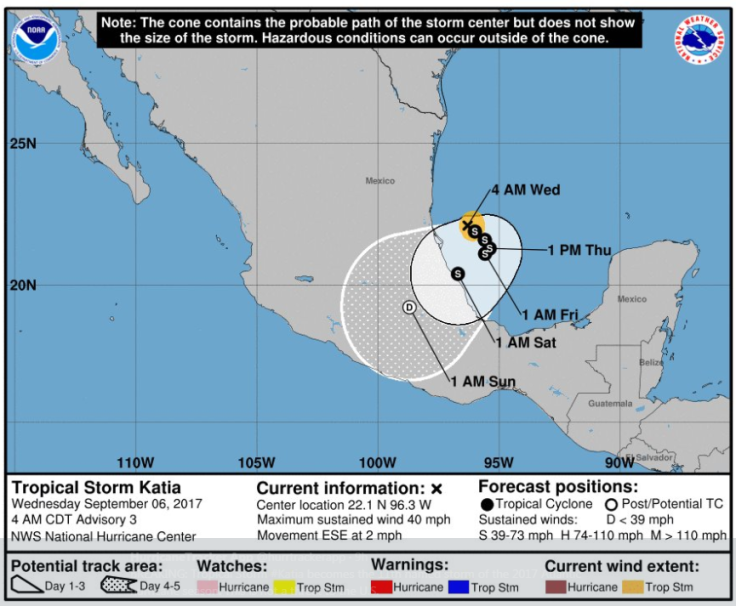Where Is Tropical Storm Katia Going And When Will It Hit?

UPDATE: 8:04 p.m. EDT — Tropical storm Katia strengthened late Wednesday afternoon into a hurricane as it swept through the Gulf of Mexico. Hurricane Katia brought winds of 75 mph as it sent rain toward eastern Mexico.
The official announcement came shortly after tropical storm Jose became an official hurricane in the Atlantic Ocean. Katia remained a Category 1 hurricane Wednesday afternoon, according to the National Hurricane Center.
Original story:
With the nation’s eyes on Hurricane Irma, yet another storm is brewing in the Atlantic Ocean. Tropical storm Katia has the potential to become a hurricane in the coming days, according to preliminary weather reports.
Beginning as Tropical Depression 13, the storm formed Tuesday in the southwestern Gulf of Mexico, strengthening into Tropical Storm Katia Wednesday morning. The storm could become a hurricane while it gathers strength in the Gulf, according to AccuWeather. The storm might become a hurricane as it approaches the coast of Veracruz, Mexico, the National Hurricane Center said Wednesday.
Katia remained about 175 miles north of Veracruz Wednesday afternoon, bringing with it winds of up to 45 mph. And while it could possibly move to the north, east and south, it will likely move “very little overall,” AccuWeather said.
BREAKING: Tropical Storm #Katia becomes the 11th named storm of the 2017 Atlantic hurricane season. This is not a threat to the U.S. pic.twitter.com/0CARPzfH5D
— Hurricane Tracker App (@hurrtrackerapp) September 6, 2017
“The system will likely end up moving inland over the northern coast of southeastern Mexico sometime late this week or this weekend,” said AccuWeather hurricane expert Dan Kottlowski.
Other possible paths mean the storm could potentially bypass the eastern Mexican shore altogether, according to local news outlet KRIS-TV. But the expected path combined with a swath of dry air over Texas and Louisiana means Katia will likely not move far enough to hit the areas already devastated by last week’s Hurricane Harvey.
As Katia stewed in the Gulf of Mexico Wednesday, Hurricane Irma hit a multitude of Caribbean islands with winds of up to 185 mph on its way toward the United States. Devastating images from St. Martin show catastrophic flooding and decimated structures. The storm was headed toward Puerto Rico where it was expected to bring “life threatening wind, storm surges and rainfall,” the National Weather Service said Wednesday. Residents in Florida, meanwhile, waited to see whether they’d be evacuated from their homes depending on Irma’s path.
“We do not know the exact path of this storm,” Florida Gov. Rick Scott said Tuesday. “But weather can change in an instant and while we hope for the best, we must prepare for the worst
© Copyright IBTimes 2024. All rights reserved.






















